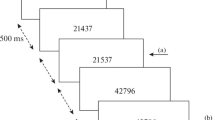Summary
Event-related potentials (ERPs) and attention performance data were collected in an auditory oddball paradigm from 24 intellectually impaired neurological patients, and compared with normal controls (n=19). For the ERP components N1, P2 and P3, reference-independent measures (latency, global field power, current density at Cz, location of extreme potential, centroid location) were determined for the target stimulus and for the preceding and the following two “frequent” stimuli. In 8 of the 45 measures obtained, patients and controls differed significantly. To target stimuli, patients had shorter N1 latency and smaller current density, more posterior P2 location and longer P3 latency; to immediately following “frequent” stimuli, longer P2 latency; and to preceding and both following “frequent” stimuli, smaller P2 current density. Attention performance was significantly worse for the 15 patients who scored on at least one of the eight ERP measures above normal range than for the other 9 patients. Decreased N1 latency to targets is viewed as failure to activate normal attentional capacity; changed P2 location suggests activation of deviant neuronal populations in response to targets; and increased post-target P2 latency suggests abnormal persistence of induced state change.
Similar content being viewed by others
References
Ball SS, Marsh JT, Schubarth G, Brown WS, Standburg R (1989) Longitudinal P300 latency changes in Alzheimer's disease. J Gerontol 44:195–200
Brown WS, Marsh JT, LaRue A (1982) Event-related potentials in psychiatry: differentiating depression and dementia in the elderly. Bull Los Ang Neurol Soc. 47:91–107
Coffman JA, Torello MW (1989) Event-related potential (N100) studies in depressed patients treated with electroconvulsive therapy. In: Maurer K (ed) Topographic brain mapping of EEG and evoked potentials. Springer, Berlin Heidelberg New York, pp 474–481
Goodin DS (1990) Clinical utility of long latency “cognitive” event-related potentials (P3): the pros. Electroencephalogr Clin Neurophysiol 76:2–5
Goodin DS, Aminoff MJ (1986) Electrophysiological differences between subtypes of dementia. Brain 109:1103–1113
Gordon E, Kraiuhin C, Harris A, Meares R, Howson A (1986) The differential diagnosis of dementia using P300 latency. Biol Psychiatry 21:1123–1132
Gummow LJ, Dustman RE, Keaney RP (1986) Cerebrovascular accident alters P300 event-related potential characteristics. Electroencephalogr Clin Neurophysiol 63:128–137
Hansch EC, Syndulko K, Cohen SN, Goldberg ZI, Potvin AR, Tourtellotte WW (1982) Cognition in Parkinson's disease: an event-related potential perspective. Ann Neurol 11:599–607
Hirata K, Lehmann D (1989) N1 and P2 of frequent and rare event-related potentials show effects and after-effects of the attended target in the oddball-paradigm. Int J Psychophysiol 9:293–301
Ito J, Yamao S, Fukuda H, Mimori Y, Nakamura S (1990) The P-300 event-related potentials in dementia of the Alzheimer type. Correlations between P300 and monoamine metabolites. Clin Neurophysiol 77:174–178
Lehmann D (1987) Principles of spatial analysis. In: Gevins AS, Remond A (eds) EEG handbook, revised series, vol I, Elsevier, Amsterdam, pp 309–354
Lehmann D, Skrandies W (1979) Multichannel evoked potential fields show different properties of human upper and lower hemi-retinal systems. Exp Brain Res 35:151–159
Lehmann D, Skrandies W (1980) Reference-free identification of components of checkerboard-evoked multichannel potential fields. Electroencephalogr Clin Neurophysiol 48:609–621
Lehmann D, Meles H, Mir Z (1977) Average multichannel EEG potential fields evoked from upper and lower hemiretina: latency differences. Electroencephalogr Clin Neurophysiol 43: 725–731
Mita T, Lehmann D, Skrandies W (1983) P300 in brain-damaged patients. Electroencephalogr Clin Neurophysiol 55:22P
Pfefferbaum A, Ford JM, Wenegrat BG, Roth WT, Kopell BS (1984a) Clinical application of the P3 component of event-related potentials. I. Normal aging Electroencephalogr Clin Neurophysiol 59:85–103
Pfefferbaum A, Wenegrat BG, Ford JM, Roth WT, Kopell BS (1984b) Clinical application of the P3 component of event-related potentials. II. Demential, depression and schizophrenia. Electroencephalogr Clin Neurophysiol 59:104–124
Pfefferbaum A, Ford JM, Kraemer HC (1990) Clinical utility of long latency “cognitive” event-related potentials (P3): the cons. Electroencephalogr Clin Neurophysiol 76:6–12
Picton TW, Hillyard SA (1974) Human auditory evoked potentials. II. Effects of attention. Electroencephalogr Clin Neurophysiol 36:191–199
Polich J, Ehlers CL, Otis S, Mandell AJ, Bloom FE (1986) P300 latency reflects the degree of cognitive decline in dementing illness. Electroencephalogr Clin Neurophysiol 63:138–144
Polich J, Ladish C, Bloom FE (1990) P300 assessment of early Alzheimer's disease. Electroencephalogr Clin Neurophysiol 77: 179–189
Rosvold HE (1956) A continuous performance test of brain damage. J Consult Psychol 20:343–350
Roth WT, Krainz PL, Ford JM, Tinkerberg JR, Rothbart RM, Kopell B (1976) Parameters of temporal recovery of the human auditory evoked potential. Electroencephalogr Clin Neurophysiol 40:623–632
Roth WT, Horvath TB, Pfefferbaum A, Kopell BS (1980) Event-related potentials in schizophrenics. Electroencephalogr Clin Neurophysiol 48:127–139
Skrandies W (1987) The upper and lower visual field of man: electrophysiological and functional differences. Prog Sens Physiol 8:1–93
Slaets JP, Fortgens C (1984) On the value of P300 event-related potentials in the differential diagnosis of dementia. Br J Psychiatry 145:652–656
St. Claire DM, Blackwood DH, Christie JE (1985) P3 and other long latency auditory evoked potentials in presenile dementia Alzheimer type and alcoholic Korsakoff syndrome. Br J Psychiatry 147:702–706
Author information
Authors and Affiliations
Rights and permissions
About this article
Cite this article
Hirata, K., Pal, I. & Lehmann, D. Event-related potential components N1, P2 and P3 to rare and frequent stimuli in intellectually impaired neurological patients. Eur Arch Psychiatry Clin Nuerosci 240, 240–245 (1991). https://doi.org/10.1007/BF02189533
Issue Date:
DOI: https://doi.org/10.1007/BF02189533




